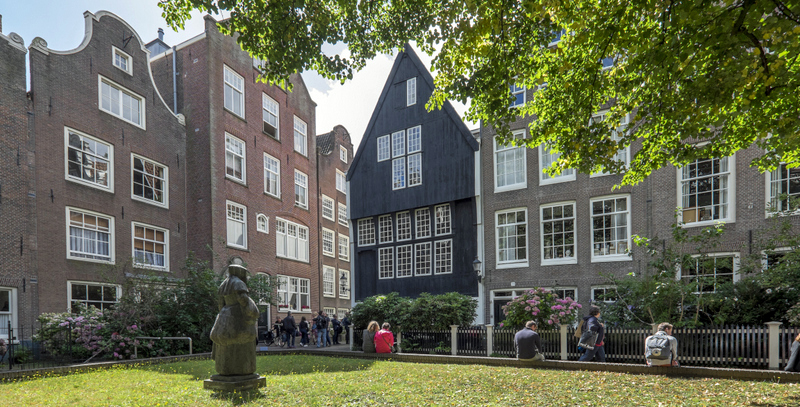Peaceful Oasis in Bustling Amsterdam
Tucked away behind Kalverstraat, you will find Begijnhof, Beguine Court, a green space that offers a welcome break from Amsterdam’s people-packed streets. Sneak into this haven of rest through a little gateway on Spui or go to the main entrance on Gedempte Begijnensloot and you will find yourself in a peaceful garden, seemingly far away from bustling Amsterdam.
Begijnhof History
Begijnhof was built in the 14th century as homes for Beguines, Catholic lay nuns who educated the poor and cared for the sick. When men took off during the crusades, society was left with an abundance of single women. Many women were widowed by the hazards of overseas trade, when their husbands never returned home from dangerous voyages.

Single Women
In the late Middle Ages, careers available to women were wifehood or the nunnery. Many single women did not want to take religious vows and became lay nuns. They cared for the needy in return for lodging. However, the Beguines living at the Amsterdam Begijnhof were different. They were women of independent means and they owned their houses. That’s why the dwellings at Begijnhof are not uniform in size and architecture.

Begijnhof Today
Only one wooden house survived the many fires that ravished Amsterdam in the Middle Ages. Today the 17th and 18th-century houses in Begijnhof encircle a central garden with the atmosphere of a village green. The last Beguine died in 1970 and since then Begijnhof has provided subsidised housing to single women.

The English Church
The church in the middle of the square dates back to the early 15th century and is the only church in Amsterdam with a tower in its original state. During the alteration in 1578, the church was confiscated from the Catholics and given to Presbyterians fleeing from England seeking refuge in liberal Amsterdam.
Mayflower
Today, the church is known as the English Church. A wall plaque commemorates the fact that some members of this group of refugees were the later Pilgrim Fathers. A stained-glass window depicts pilgrims praying before boarding the Mayflower and sailing for America.
Cornelia
Cornelia Arens, a seventeenth century beguine, loved the Begijnhof so much that she asked to be buried in the gutter. Her wish was not granted. She rests under under a slab of red granite on the left side of the church.

Begijnhof Chapel
After their church had been confiscated, the Beguines went without a church for almost a century. In 1671, the Protestant authorities allowed them to have a clandestine church in which they and other Catholics attended mass in secret until freedom of religion was restored at the end of the 18th century

Silent Procession
Each year on or close to 15 March, pilgrims flock in their thousands to Amsterdam to take part in the Silent Procession through the Amsterdam’s old centre. It begins with Holy Mass at the church at Begijnhof Chapel. The procession is held in absolute silence, no singing, no praying, no religious attributes and no clerical attire.

Begijnhof Courtyard
In 1521, Amsterdam municipality banned all wooden buildings because these houses had become fire hazards. That’ s why most houses in Begijnhof date from the 17th century and later. The only exception is No 34, the Houten Huys, the Wooden House, dating back to 1465. In front of this house is a charming statue dedicated to all Beguines who once lived in Begijnhof.

Gable Stones
Elegantly carved gable stones adorn many house fronts. They identified dwellings until 1795, when Napoleon introduced house numbers. Next to the wooden house you will find naughty images, that is to say naughty in the Middle Age – roosters, they are male, dogs, they are dirty animals, and male humans over the age for three, standing for dangerous living.

Getting there
The Begijnhof is located in Amsterdam centre. The easiest way to get there is via Spuiplein. The entrance gate is through a brown house in a row of white houses. The Begijnhof is open daily from 09.00-17.00.
You can walk along the paths that are indicated for visitors. Small fences block the other paths. Residents are not very happy when you take photos or selfies of their homes.
Address: Nieuwezijds Voorburgwal 373, Amsterdam
Next article: Royal palace at Dam Square
Previous article: Oude Kerk, oldest church in Amsterdam, now a museum
photos Marianne Crone



